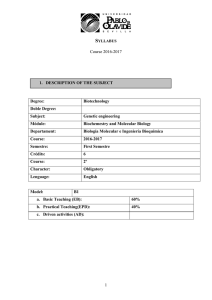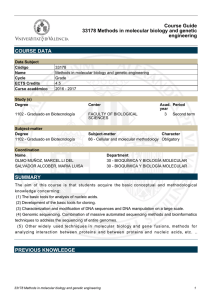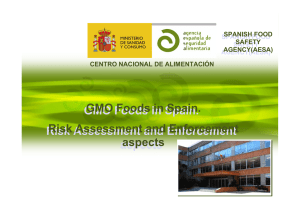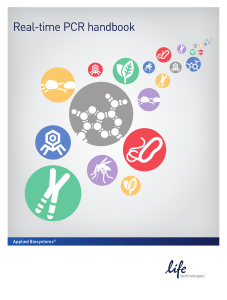Ciencia y Tecnologia Alimentaria. 5
Anuncio
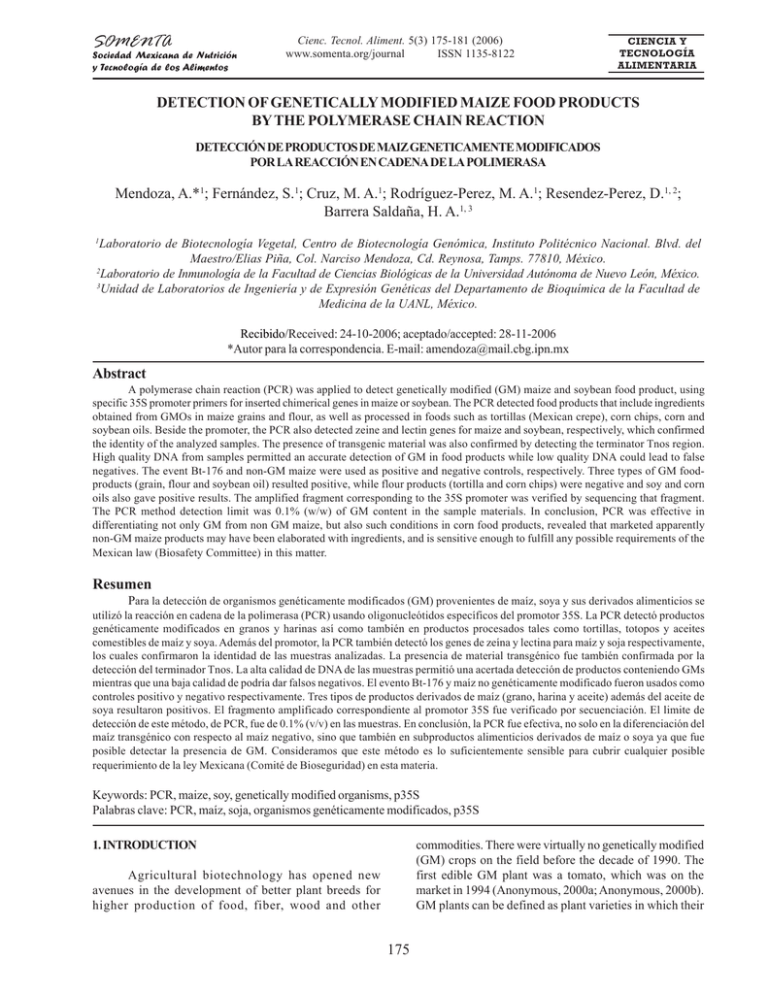
SOMENTA Sociedad Mexicana de Nutrición y Tecnología de los Alimentos Cienc. Tecnol. Aliment. 5(3) 175-181 (2006) www.somenta.org/journal ISSN 1135-8122 CIENCIA Y TECNOLOGÍA ALIMENTARIA DETECTION OF GENETICALLY MODIFIED MAIZE FOOD PRODUCTS BY THE POLYMERASE CHAIN REACTION DETECCIÓN DE PRODUCTOS DE MAIZ GENETICAMENTE MODIFICADOS POR LA REACCIÓN EN CADENA DE LA POLIMERASA Mendoza, A.*1; Fernández, S.1; Cruz, M. A.1; Rodríguez-Perez, M. A.1; Resendez-Perez, D.1, 2; Barrera Saldaña, H. A.1, 3 Laboratorio de Biotecnología Vegetal, Centro de Biotecnología Genómica, Instituto Politécnico Nacional. Blvd. del Maestro/Elias Piña, Col. Narciso Mendoza, Cd. Reynosa, Tamps. 77810, México. 2 Laboratorio de Inmunología de la Facultad de Ciencias Biológicas de la Universidad Autónoma de Nuevo León, México. 3 Unidad de Laboratorios de Ingeniería y de Expresión Genéticas del Departamento de Bioquímica de la Facultad de Medicina de la UANL, México. 1 Recibido/Received: 24-10-2006; aceptado/accepted: 28-11-2006 *Autor para la correspondencia. E-mail: [email protected] Abstract A polymerase chain reaction (PCR) was applied to detect genetically modified (GM) maize and soybean food product, using specific 35S promoter primers for inserted chimerical genes in maize or soybean. The PCR detected food products that include ingredients obtained from GMOs in maize grains and flour, as well as processed in foods such as tortillas (Mexican crepe), corn chips, corn and soybean oils. Beside the promoter, the PCR also detected zeine and lectin genes for maize and soybean, respectively, which confirmed the identity of the analyzed samples. The presence of transgenic material was also confirmed by detecting the terminator Tnos region. High quality DNA from samples permitted an accurate detection of GM in food products while low quality DNA could lead to false negatives. The event Bt-176 and non-GM maize were used as positive and negative controls, respectively. Three types of GM foodproducts (grain, flour and soybean oil) resulted positive, while flour products (tortilla and corn chips) were negative and soy and corn oils also gave positive results. The amplified fragment corresponding to the 35S promoter was verified by sequencing that fragment. The PCR method detection limit was 0.1% (w/w) of GM content in the sample materials. In conclusion, PCR was effective in differentiating not only GM from non GM maize, but also such conditions in corn food products, revealed that marketed apparently non-GM maize products may have been elaborated with ingredients, and is sensitive enough to fulfill any possible requirements of the Mexican law (Biosafety Committee) in this matter. Resumen Para la detección de organismos genéticamente modificados (GM) provenientes de maíz, soya y sus derivados alimenticios se utilizó la reacción en cadena de la polimerasa (PCR) usando oligonucleótidos específicos del promotor 35S. La PCR detectó productos genéticamente modificados en granos y harinas así como también en productos procesados tales como tortillas, totopos y aceites comestibles de maíz y soya. Además del promotor, la PCR también detectó los genes de zeína y lectina para maíz y soja respectivamente, los cuales confirmaron la identidad de las muestras analizadas. La presencia de material transgénico fue también confirmada por la detección del terminador Tnos. La alta calidad de DNA de las muestras permitió una acertada detección de productos conteniendo GMs mientras que una baja calidad de podría dar falsos negativos. El evento Bt-176 y maíz no genéticamente modificado fueron usados como controles positivo y negativo respectivamente. Tres tipos de productos derivados de maíz (grano, harina y aceite) además del aceite de soya resultaron positivos. El fragmento amplificado correspondiente al promotor 35S fue verificado por secuenciación. El limite de detección de este método, de PCR, fue de 0.1% (v/v) en las muestras. En conclusión, la PCR fue efectiva, no solo en la diferenciación del maíz transgénico con respecto al maíz negativo, sino que también en subproductos alimenticios derivados de maíz o soya ya que fue posible detectar la presencia de GM. Consideramos que este método es lo suficientemente sensible para cubrir cualquier posible requerimiento de la ley Mexicana (Comité de Bioseguridad) en esta materia. Keywords: PCR, maize, soy, genetically modified organisms, p35S Palabras clave: PCR, maíz, soja, organismos genéticamente modificados, p35S 1. INTRODUCTION commodities. There were virtually no genetically modified (GM) crops on the field before the decade of 1990. The first edible GM plant was a tomato, which was on the market in 1994 (Anonymous, 2000a; Anonymous, 2000b). GM plants can be defined as plant varieties in which their Agricultural biotechnology has opened new avenues in the development of better plant breeds for higher production of food, fiber, wood and other 175 Cienc. Tecnol. Aliment. 5(3) 175-181 (2006) ISSN 1135-8122 ©2006 SOMENTA native genetic material has been modified by recombinant DNA technology, introducing in their germ lines new genes or genetic elements. Nowadays the situation has changed dramatically. The estimated global cultivated area of transgenic or GM crops in 2001 was already 52.6 million hectares in 13 different countries (Anonymous, 2000c). After the first commercial introduction of a GM crop, cultivation of several transgenic crop species has grown rapidly to more than 40 million worldwide (Anonymous, 2000b; Anonymous, 2000c). There have been 18 types of GMmaize approved by the US government for the market (Fernández-Cornejo and Mcbride, 2002). In Europe, two of these represent the majority of the GM-maize on the market (Díaz-Bonilla and Robinson, 2001). In Mexico, only GM-Tomato, soybean and Cotton have been approved since 1998, and these are grown on only a few hectares (Díaz-Bonilla and Robinson, 2001). The addition of foreign genes to GM plants was initially pursued to produce novel proteins that confer pest and disease resistance. In the European Union (EU), the release of GM organism (GMO) in the environment are strictly regulated (Anonymous, 2000b; Horowitz, 1988; Haslberger, 2000). The polymerase chain reaction (PCR) is widely used in many fields to detect minimal amounts of DNA with a high degree of specificity. Several PCR systems have been described for various applications of food control, e.g. identification of species in meat (Beachy, 1999, Brett, 1999; Anonymous, 2000b), fish products (Gaskell et al., 1999; Hardegger, 1999), food components (Anonymous, 2000c; Schreiber, 1999), and detection of GMOs, such as tomato, soybean (Ming, 2002) and maize (Lih et al., 2002; Studer et al., 1998). Two different types of PCR systems can be distinguished for detection of GMOs: screening methods and specific tests. Screening methods are not specific for one particular GMO but detect commonly used elements in genetic engineering, such as gene promoter or terminator elements, e.g. the 35S promoter of cauliflower mosaic virus (CaMV) or the NOS terminator of Agrobacterium tumefaciens (Ahmed, 1999). Besides the screening methods, the highly specific tests can detect one particular GMO. To date, a few PCR screening methods for the detection of genetically modified plants have been described that are not specific for one particular GMO (Ming, 2002), whereas a few others are for one GMO (Lih et al., 2002; Ming 2002). In addition, PCR provides a reliable tool for identifying GMOcontaining foods, and therefore for controlling the food labeling regulations concerning GMOs (Gilbert, 1999; Lih et al., 2002) and their traceability. The legal provisions are different for GMOs and GM foods. One example of such a difference is the existence of a minimal threshold for food labeling that has no counterpart, for instance, in the labeling of GM grains. This so-called «threshold regulation» specifies that foodstuffs must be subject to labeling if material derived from GMOs is present in the food ingredients in a 1% of the food ingredients individually considered (Gaskell et al., 1999). The need to monitor and verify the presence and amount of GMOs in agricultural crops and in their derived products has generated a demand for analytical methods capable of detecting, identifying and quantifying either DNA introduced or protein(s) expressed in transgenic plants (Cochet et al., 1998, Gilbert, 1999; Hardegger, 1999; Studer et al., 1998). Up to now, the DNA content was of minor interest in food analysis and not much experimental work has been reported in this area. Therefore, data showing which food or food fraction contain DNA are still largely unavailable. The need for more stringent food quality control which should include determination of the origin of the product need to be highlighted, as a guarantee of the product’s innocuity (Pauli et al., 1998; Schreiber 1999). This is particularly true for soybean and free all-trans fatty acids maize oils. The availability of a reliable method for DNA extraction from highly processed maize and soybean food products is crucial for this challenge to be addressed successfully. The co-amplification of competitors together with target DNA using PCR has proven to be a useful quantitative technique (Grupta, 2000). In this study, development and evaluation of a 35S-promoter PCR based on a published, non-competitive PCR system (Ming, 2002; Stave, 1999) is described. The method here described enables the successful extraction of DNA and detection of maize and soybean food products that include ingredients obtained from GMOs. The advantage of this screening method is the ability to detect 90% of the GM products with the same method. The Mexican government (Biosafety Committee) requires this kind of method to be added to its bio-safety law to help release the pressure in countries where the following situations prevail: incomplete or missing legislation regarding the experimental release or commercialization of GMOs; limited experience with GMOs; limited scientific and technological capabilities to assess the risk of GMOs. 2. MATERIALS AND METHODS 2.1. Maize food products The following four types of maize food products were employed in the present study: maize seeds, flour, tortillas (Mexican crepes), and highly processed products such as corn chips and commercial corn and soybean oil. As a positive control, we used GM-Maize Bt-176 (Novartis Pty Ltd). 2.2. Extraction and Purification of DNA Near 10 µg (A260 nm) of genomic DNA, was isolated from 4 g of grains or flour by the WIZARD Genomic DNA extraction Kit (Promega, Madison, WI.) according to the manufacturer’s instructions. However, 176 SOMENTA ©2006 Mendoza et al.: Detection of genetically modified maize ... DNA extraction from maize food products such as «Mexican crepes» and corn chips was performed by a series of Phenol/Chloroform/Octanol extractions (25:24:1 v/v) after cell lysis. Cellular proteins were then removed by adding 200 µL of salt-precipitation solution (1 M Tris pH 7.4, 0.25 M NaCl and 2 M EDTA) which precipitates the proteins but leaves the high molecular weight genomic DNA in solution. It is important to eliminate any traces of fats present in the extraction mixture. For DNA extraction of corn and soybean oils, vials with 1 ml of oil were homogenized vigorously using a vortex to evenly distribute residual soybean particles. Samples of 400 µL of this suspension were removed and treated as follows: 600 µL of a Lysis Solution (Promega, Madison, WI) was added, the samples were incubated at 65 °C for 15 min. The cellular proteins were then removed as described above. Protein and cell debris were pelleted by centrifugation at 13,000 X g for 3 min at room temperature. The supernatant was transferred to a clean tube and protein excess was extracted by adding equal volume of Phenol/Chloroform/Octanol (25:24:1) then overturn the tube for 3 min. After centrifuging at 13000 X g for 5 min, the supernatant was transferred to a new tube, and then the DNA was precipitated by adding 1/10 volume of 3 M Sodium Acetate plus 3 volumes of ice-cold ethanol. The DNA was recovered by centrifuging at 14, 000 X g for 5 min and finally, the pellet DNA was resuspended in 50 µL of Milli Q sterile water. Careful separation of DNA from normal contaminants, such as vegetable oils or fatty acids typically present in these kinds of foods was then performed by using a Whatman paper strips filter. After RNase digestion (0.4 µg/µl), DNA quality was measured by comparison to DNA mass standards, while quantity was estimated by agarose gel electrophoresis. However, accurate quantification was hampered due to the fact that genomic DNA from processed food and food stuffs was often heavily degraded and did not migrate as one defined band on gels. In spite of this, gel electrophoresis provided qualitative information such as the degree of DNA degradation due to food processing which was not revealed by spectrophotometric determinations. 1 2 3 4 5 1 300 150 50 A B 2 3 4 5 6 zein 35S lectin Int. control Figure 1. Genomic DNA and PCR transgenic detection from maize grains. A) DNA was adjusted to 100 ng/µl, and loaded in a 1 % agarose gel. Lane 1 and 2 is genomic DNA from GM maize Bt176; Lanes 3-5 are DNA from non-transgenic maize plants. B) PCR products amplified from transgenic (Bt-176) and nontransgenic maize. PCR analysis includes the zein gene (278 bp) as a positive control for maize samples, lectin (163 bp) for soybean and the 35S promoter (227 bp) for transgenic material. Lane 1: Bench Top PCR marker; Lane 2: negative control (without DNA template); Lane 3: non-transgenic DNA; Lanes 4 – 5: Bt-176 GMmaize; Lane 6: positive control. The 35S promoter amplified, showed the expected fragment of 227 bp for both, Bt-176 GMmaize and the positive control, while no 35S amplification product was detected for non GM-maize and the negative control, indicating no contamination. Fragments were visualized in a 2% agarose gel Ethidium Bromide stained. Figura 1. DNA genómico y detección por PCR de granos de maíz transgénico. A) ADN ajustado a 100 ng/µl y cargado en un gel de agarosa al 1%. Carril 1 y 2 DNA genómico de maíz transgénico Bt-176; Carriles 3-5 ADN de plantas de maíz no transgénicas. B) Productos de PCR amplificados de maíz transgénico (Bt-176) y no transgénico. Los análisis de PCR incluyen el gen de zeina (278 pb) como un control positivo para muestras de maíz, lectina (163 pb) para soya y el promotor 35S (227 pb) para material transgénico. Carril 1: Marcador Bench Top; Carril 2: control negativo (sin ADN molde): Carril 3: DNA no transgénico. Carril 4-5: Maíz genéticamente modificado Bt-176. Carril 6: control positivo. El promotor 35S amplificado, mostró el fragmento esperado de 227 pb para ambos maíz genéticamente modificado Bt-176 y control positivo, mientras que no fue detectado el producto de amplificación del 35S para el maíz no genéticamente modificado y el control negativo, indicando que no hubo contaminación. Los fragmentos fueron visualizados en un gel de agarosa al 2% teñido con Bromuro de Etidio. guarantees a highly reproducible sensitivity of 0.05 % (>95 %) for the 35S promoter (Zimmermann et al., 1998). The PCR system detected maize (zein), soybean (lectin) and CaMV 35S promoter gene sequences simultaneously. Additionally, this method includes an internal control to indicate failure of the PCR due to inhibitors, so that no false negative results would be reported. The multiplex PCR screening system was performed using 400 ng of DNA template (5 µL), internal control template (5 µL), 40 µL of Master mix (10 mM dNTPs, 2.5 mM MgCl2, and 10mM of primers for zein, lectin and 35S promoter) and 1 unit of HotStarTaq DNA polymerase per assay, in a final volume 2.3. PCR and gel Electrophoresis A Programmable PCR thermocycler, GenAmp PCR system 9700 from Perkin Elmer (Newark CT), was used for amplification of possible transgenic and control genes from the food products. Agarose gels usually at 2% were run in submerged horizontal electrophoresis chambers from BioRad (Hercules, CA). 2.4. Amplification and Detection A multiplex PCR system for detecting maize, soybean and the 35S promoter, was used in this study. This method gives reliable GMO screening detection and 177 Cienc. Tecnol. Aliment. 5(3) 175-181 (2006) ISSN 1135-8122 of 50 µL. The reaction mixture was subjected to the following program: an initial denaturating step of 15 min at 95 °C, was followed by 5 cycles of 20 sec at 95 °C and 1 min at 66 °C; 5 cycles of 20 sec at 95 °C ,1 min at 62 °C and 1 min at 72 °C; 5 cycles of 20 sec at 95 °C, 1 min at 58 °C and 1 min at 72 °C; 10 cycles of 20 sec at 95 °C, 1 min at 54 °C and 1 min at 72 °C; 15 cycles of 20 sec at 95 °C, 1 min at 50 °C and 1 min at 72 °C ; and finally 15 cycles of 20 sec at 95 °C, 1 min at 45 °C and 20 sec at 72 °C. The synthesis was completed by a final incubation at 72 °C for 10 min. 1 2 3 4 5 6 ©2006 SOMENTA 7 8 1 2 3 4 5 6 7 8 500 300 150 2.5. Detection of Terminator gene region. Tnos-specific system To verify the presence of transgenic material in the different food products (positive for the 35S promoter) specific primers for the Tnos terminator were designed, being: TNOSF: 5’- gaa tcc tgt tgc cgg tct tg- 3’ and TNOSR: 5’- tta tcc tag ttt gcg cgc ta- 3’. The expected amplified product is of 125 bp. The PCR was performed using 400 ng of DNA template, 200mM dNTPs, 1.5 mM MgCl2, 10 mM of Tnos primers and 1 unit of TaqDNA polymerase per assay, in a final volume of 25 L. The reaction mixture was subjected to the following program: initial denaturizing step of 10 min at 95 °C, followed by 50 cycles of 25 sec at 95 °C, 30 sec at 55 °C and 45 sec at 72 °C; a final extension cycle of 72 °C was included. A B zein 35S Internal Control Figure 2. Genomic DNA and PCR transgenic detection in genomic DNA isolated from different food products. A) Genomic DNA. Lane 1 and 2: DNA of flour; lane 3-6: DNA of «tortilla» (Mexican crepe) of different lots; Lane 7-8: DNA of maize grains. B) PCR products amplified from 35S promoter region of various food products. Lane 1: Bench Top PCR marker; lane 2: negative control (without DNA template); lanes 3-5: «tortilla»; lane 6: flour; lane 7: grain, and lane 8: positive control. The presence of the 35S promoter in flour (lane 6) and grain (lane 7) samples indicated that they came from transgenic material, due to the presence of the 35S promoter. However, the tortilla (Mexican crepes) samples did not show any evidence of transgenic material (lanes 3-5), since the 35S was not amplified. Figura 2. ADN genómico y detección de transgénicos por PCR en ADN genómico aislado de diferentes productos alimenticios. A) ADN genómico. Carril 1 y 2: ADN de harinas; Carril 3-6: ADN de tortilla de diferentes lotes; Carril 7-8: ADN de granos de maíz. B) Productos de PCR amplificados del promotor 35S de varios productos alimenticios. Carril 1: Marcador de PCR Bench Top; Carril 2: control negativo (sin ADN molde); Carril 3-5: tortilla, Carril 6: harina, Carril 7: grano y Carril 8: control positivo. La presencia del promotor 35S en muestras de harina (carril 6) y grano (carril 7) indica que proceden de material transgénico, debido a la presencia del promotor 35S. Sin embargo, la muestra de tortilla no mostró evidencia de material transgénico (carril 3-5), debido a que el 35S no amplificó. 2.6. Verification of the P35S amplified fragment by shouthern blot and sequencing To verify the identity of the 227 bp amplified product, corresponding to the 35S promoter, it was cloned into vector pCR2.1 (Invitrogene, California, USA). The cloned PCR product was sequenced with the Sequi Therm Excell II DNA sequencing kit using a Li-COR DNA sequencer (Lincoln, NE, USA). At the same time, Southern analysis was performed of food samples of transgenic and non-transgenic material. DNA was hybridized to a 227-bp PCR probe of the 35S promoter region by using chemiluminescent detection with CSPD following the protocol of Dig High Prime DNA Labeling and Detection Starter KIT II Roche Diagnostics GmbH (Indianapolis, IN). concentration to 100 ng/mL. As shown, (Figure 1A) in both cases the quality of the DNA was good, and thus was suitable for PCR analyses. These methods also showed successful genomic DNA extraction of maize grain derivatives, whether primary (flour) or secondary (tortilla) (Figure 2A), as well as from industrialised products, tortilla chips and vegetable oils (Figure 3A). It is important to note that the isolated DNA was of high quality even when extracted from tortillas and corn chips. It is also important to note that, when we tried to extract DNA from corn chips, we found that it is very important to eliminate any traces of fatty acids or fats present in the extraction mixture. In our experience, these waste products compromise the sensitivity of the multiplex PCR (data not shown). DNA extracted from vegetable oil samples (soybean and maize) cannot be visualized in agarose gels because the amount usually recovered from this kind of food product are underdetectable in an agrose gel ethidium bromide stained. 3. RESULTS AND DISCUSSION 3.1. DNA extraction Detection of transgenes and/or their products might become difficult in foods, which are highly processed or refined, such as starch, sugar or vegetable oils. Thus, the efficiency of the PCR, as with any other DNA assay, depends on the DNA quality and purity. Methods for DNA extraction from plant tissue are well established, but not for industrialized food products (Lih et al., 2002). As positive and negative controls, we isolated DNA from GM maize plant tissue (Bt-176) and from a non-transgenic maize plant tissue, respectively. We routinely adjusted the DNA 178 SOMENTA ©2006 N Mendoza et al.: Detection of genetically modified maize ... M 2 3 1 2 3 4 5 6 7 500 bp 300 Zein 35S Lectin 500 300 150 A 1 150 Tnos 50 B Figure 3. Genomic DNA isolated from industrialized food product (maize chips). A) Isolated genomic DNA. B) PCR of the maize chips DNA. Lane M: Bench Top PCR marker; lane 1: negative control (without DNA template); lane 2: Maize chips, shows only the zein gene indicating that they do not come from a GMO; lane 3: positive control which shows the 35S and zein genes amplified. Figure 4. Detection of the terminator gene region, Tnos-specific sequence: Lane 1: Bench Top marker; lane 2: positive maize oil; lane 3: positive soybean oil; lane 4: positive maize grain; lane 5: positive flour; lane 6 positive control for the Tnos (125 bp) amplified fragment shown for the same food samples positives for P35S. and lane 7: event Bt-176 (negative control for Tnos). Figura 3. ADN genómico aislado de productos alimenticios industrializados (frituras). A) ADN genómico aislado. B) PCR del ADN de totopos. Carril M: Marcador de PCR Bench Top, Carril 1: control negativo (sin ADN molde); Carril 2: las frituras solo mostraron el gen de la zeína indicando que ellos no derivaban de maíz transgénico; Carril 3: control positivo que muestra los genes del 35S y zeína amplificados. Figura 4. Detección de la región del gen terminador, secuencia especifica para el Tnos: Carril 1: Marcador Bench Top, Carril 2: aceite de maíz positivo; Carril 3: aceite de soya positivo; Carril 4: grano de maíz positivo; Carril 5: harina positiva: Carril 6: control positivo para Tnos (125 pb); Carril 7: evento Bt-176 (control negativo para Tnos). However, there is enough genomic DNA to be detected by PCR. Otherwise our controls, such as zein and lectin genes would not have been amplified. transgenic maize). As shown in Figure 1B, the 35S promoter was amplified, yielding the expected fragment of 227 bp in the positive control, while no 35S amplification product was detected for the negative control, indicating no contamination. As a multiplex PCR, harboring primers for the zein gene and internal control, these were also amplified, indicating a successful PCR reaction. Considering these results, we proceeded to analyze the isolated DNA from the food products under study. The presence of the 35S promoter in grain and flour samples (Figure 2B) indicated that they were contaminated with transgenic material. However, the tortilla samples did not show any evidence of transgenic material, since the 35S was not amplified in any of the samples for the three times that the nested PCR was performed. Even when the extracted DNA from the tortilla chips was analyzed using nested PCR, no 35S promoter was found (Figure 3B). This negative result clearly indicates that the product does not need to be labeled as GMO. Due to the internal control, false negative results would clearly be detectable when present. Furthermore, when the positive food samples were analyzed by the presence of the TNOS sequence, all of them were also amplified (Figure 4). These results could be used as a double check for positive food samples and at the same time is very advantageous for the Biosafety Law in Mexico. Additionally, the detection of soybean and 3.2. PCR amplification It has been recommended that the primers used in PCR detection of GM foods should yield amplification products in the range of 150 to 300 bp (Studer, 1998). The amplification products of primers used in the present study are all smaller than 270 bp; therefore these primers are suitable for the detection of market available maize grains and processed products. Detection of DNA and/or proteins might become difficult when processed food and highly refined ingredients, such as starch, sugar or vegetable oils are used, and as was mentioned previously, the quality of the isolated DNA is essential for successful PCR gene amplification. The extracted genomic DNAs from these products were used as a template for nested PCR. This analysis included the detection of the zein gene (278 bp) as a positive control for maize samples, the lectin gene (163 bp) for soybean and the CaMV 35S promoter (227 bp) for transgenic material. The PCR assay was applied to the isolated DNAs from the positive (Bt-176) and negative control (non- 179 Cienc. Tecnol. Aliment. 5(3) 175-181 (2006) 1 2 3 4 ISSN 1135-8122 5 1 2 3 4 5 ©2006 SOMENTA 6 7 1 2 3 4 5 6 7 P35S 300 pb 150 zein 35 S lectin Figure 6. Southern blot of transgenic and non-transgenic food products vs 35S promoter probe. A) PCR of transgenic and nontransgenic food samples. B) Lane: 1. - Ladder 100 bp; 2. experimental transgenic maize DNA (has two transgene insertions); 3.- negative control (no template); 4.- Non-transgenic maize grain; 5.- Event Bt-176; 6.- Non-transgenic maize flour; 7.- Transgenic maize oil. Figure 5. PCR transgenic detection in genomic DNA isolated from Soybean and Maize oils. Lane 1: weight marker l PstI; lane 2: positive control; Lane 3: negative control; Lane 4: soybean oil; lane 5: maize oil. The 35S (227 bp) amplified fragment is shown and zein and lectin genes were amplified for soybean and maize oil samples, respectively. Figura 6. Hibridación de productos alimenticios transgénicos y no transgénicos vs una sonda del promotor 35S. A) PCR de muestras alimenticias provenientes de transgénicos y no transgénicos. B) Carril 1: Marcador de 100 pb; Carril 2: ADN de maíz transgénico experimental (tiene dos inserciones de transgen): Carril 3: control negativo (sin templado); Carril 4: grano de maíz no transgénico; Carril 5: Evento BT-176; Carril 6: harina de maíz no transgénica; Carril 7: Aceite de maíz transgénico. Figura 5. Detección de transgénicos por PCR en ADN genómco aislado de aceite de maíz y soya. Carril 1: Marcador de peso molecular lPstI; Carril 2: control positivo; Carril 3: control negativo; Carril 4: aceite de soya; Carril 5: aceite de maíz. Se observó el fragmento amplificado del 35S (227 pb) y los genes de lectina y zeína fueron amplificados para aceite de soya y de maíz respectivamente. maize in the same assay is very helpful because some samples show contamination of maize in soybean and vice versa. Figure 5 shows the 35S PCR amplifications from soybean and maize oil extractions, where it is clear that both oils were found to contain transgenic material. This is not surprising because there is no legislation in Mexico prohibiting GMO utilization in vegetable oils. We also believe this is one of the first studies showing the feasibility of isolating DNA of good enough quantity and quality for GMO detection, mainly from highly processed food products, such as vegetable oils (Busconi et al., 2003). In addition, It has been postulated that southern blot remains a fundamental tool for insert characterization and is the method of choice to: Confirm the size and structure of insert, determine the copy number of the insert. As is shown in Figure 6, southern blot confirmed that the amplified fragment belongs to the 35S promoter. It also shows, that the experimental maize plant has two copies of the 35S promoter, thus we could assume that it has a double transgene insertion. Besides this, the probe method also allows us to determine the copy number or gene insertion. Furthermore, the sequence obtained from the amplified fragment, corresponding to any transgenic food product, confirmed that it corresponded to the 35S promoter from the Cauliflower Mosaic Virus Acc No. CAMVG1 (Figure 7). The reproducibility of these results AmplFrag P35S CCAAGCTTGGTACCGAGCTCGGATCCACTAGTAACGGCCGCCAGTGTGCTGGAATTCGGC ------------------------------------------------------------ AmplFrag P35S TTGATAGTGGGATTGTGCGTCATCCCTTACGTCAGTGGAGATATCACATCAATCCACTTG --GATAGTGGGATTGTGCGTCATCCCTTACGTCAGTGGAGATATCACATCAATCCACTTG ********************************************************** AmplFrag P35S CTTTGAAGACGTGGTTGGAACGTCTTCTTTTTCCACGATGCTCCTCGTGGGTGGGGGTCC CTTTGAAGACGTGGTTGGAACGTCTTCTTTTTCCACGATGCTCCTCGTGGGTGGGGGTCC ************************************************************ AmplFrag P35S ATCTTTGGGACCACTGTCGGCAGAGGCATCTTGAACGATAGCCTTTCCTTTATCGCAATG ATCTTTGGGACCACTGTCGGCAGAGGCATCTTGAACGATAGCCTTTCCTTTATCGCAATG ************************************************************ AmplFrag P35S ATGGCATTTGTAGGAGC ATGGCATTTGTAGG--************** Figure 7. Nucleotide sequence alignment of P35S. Amplified PCR product from transgenic food products corresponding to 35S promoter. As a reference sequence, P35S (Acc. no. CAMVG1 ) is included. Figura 7. Alineamiento de la secuencia nucleotídica del P35S. Productos de PCR amplificados de productos alimenticios transgénicos correspondientes al promotor 35S. Se incluye una secuencia de referencia del P35S (Número de acceso CAMVG1). was evidenced in three independent PCR reactions. Thus, we can be confident that this commercial product is free of any transgenic material. There is an essential necessity of high and constant quality of an analysis-system. Therefore, it is important to include the lectin primers in the multiplex PCR when flour samples are analyzed, because wheat flour is sometimes mixed with flour obtained from soybean. The disadvantage of this method is that it 180 SOMENTA ©2006 Mendoza et al.: Detection of genetically modified maize ... is time consuming, due to the nested assay and the possible risk of contamination. The screening system used to detect the presence of transgenic elements in food products, according to the sensibility validation reported exhibit a detection limit of 0.1 % for GMO, which is sensitive enough to fulfill any possible requirements of Mexican law (Köppel, R.; Köppel, E.; Waeber, U. 2005. Validation of multiplex single PCR system. Biosmart GmbH, 2005. Bern, Switzerland, homepage: www.biosmart.ch) That limit is set at the level of ingredients and therefore, if a final product scores positive after a screening method, its respective ingredients should be quantitatively assayed to assess if it contains less or more than 1 % GMO. The content of food products is important for consumer’s right to know about food safety. Not providing this information could be a violation of consumers‘ rights and, thus negatively impact the development of biotechnology. Anonymous 2000c. Editorial Review. Overseeing biotech foods. Genetic Engineer. News 20, 37-83. Ahmed, F. E. 1999. Safety standards for food contaminants. In Environmental Contaminants in Food (Moffat, C.F. and Whittle, K. J., eds), Ch.13 pp. 500-570, Sheffield Academic Press. Beachy, R. N. 1999. Facing fear of biotechnology. Science 285, 335. Brett, G. M. 1999. Design and development of immunoassays for detection of proteins. Food Control 10, 401-406. Busconi, M.; Foroni, Ch.; Corradi, M.; Bongiorni, C.; Cattapan, F.; Fogher, C. 2003. DNA extraction from olive oil and its use in the identification of the production cultivar. Food Chemistry 83, 127 –134. Cochet, O. J.; Teillaud, L.; Sautés, C. 1998. Immunological Techniques Made Easy. John Wiley. 352 p. Diaz-Bonilla, E.; Robinson, S. 2001. Biotechnology, trade and hunger, in IFPRI 2000-2001. Annual Report. International Food Policy Research Institute. Fernandez-Cornejo, J.; Mcbride, W. D. 2002. Adoption of Bioengineered Crops. Agricultural Economic Report No 810. USDA, ARS. Gaskell, G.; Bauer, M.; Durant, J.; Allum, N. 1999. Worlds apart? The reception of genetically modified foods in Europe and the U.S. Science 285, 384-387. Grupta, A. 2000. Governing trade in genetically modified organisms. The Cartagena Protocol on Biosafety. Environment 42, 22-23. Gilbert, J. 1999. Sampling of raw materials and processed foods for the presence of GMOs. Food control 10, 363-365. Horowitz, W. 1988. Interdivisional Working Party for Harmonization of Quality Assurance Schemes for Analytical Laboratories. Pure Applied Chemistry 60, 855-867. Haslberger, A. G. 2000. Monitoring and labelling for genetically modified products. Science 287, 431-432. Hardegger, M. 1999. Quantitative detection of the 35S promoter and the NOS Terminator using quantitative competitive PCR. European Food Reserch Technology 209, 83-87. Lih, Ch.; Chen, Y.; Chih-Shih, D. Y. 2002. Study on the detection method of six varieties of genetically modified maize and processed foods. Journal of Food and Drug Analysis 10, 25-33. Ming, Pan T. 2002. Current status and detection of genetically modified organisms. Journal of Food and Drug Analysis 10, 229-241. Pauli, U.; Liniger, M.; Zimmermann, A. 1998. Detection of DNA in soybean oil. Zeitschrift Lebensmitteluntersuchung und Forschung A 207, 264-267. Schreiber, G. A. 1999. Challenges for methods to detect genetically modified DNA in foods. Food control 10, 351-352. Stave, J. W. 1999. Detection of new or modified proteins in novel foods derived from GMO-future needs. Food Control 10, 367-374. Studer, E.; Rhyner, C.; Luthy, J.; Hubner, P. 1998. Quantitative competitive PCR for detection of genetically modified soybean and maize. Zeitschrift Lebensmitteluntersuchung und Forschung A 207, 207-213. Zimmermann, A.; Lüthy, J.; Pauli, U. 1998. Quantitative and qualitative evaluation of nine different extraction methods for nucleic acids on soya bean food samples. Zeitschrift Lebensmitteluntersuchung und Forschung A 207, 81-90. 4. CONCLUSION The results presented here show that both (35S promoter and TNOS) screening methods for genetically modified and conventional food products such as grains, flour, corn chips and even from vegetable oils, are sensitive enough. However, the real-time PCR proves to be more suitable for the diagnostic laboratory than conventional PCR, due to its quantitative performance and greater sensitivity. Therefore, the sensibility and certitude of correct GM detection strongly depends on the quality and quantity of the genomic DNA extraction. Thus we can to mention that to be able to isolate enough DNA in quality and quantity for PCR amplification is one the most important contributions. ACKNOWLEDGEMENTS We would like to thank the CGPI-Instituto Politécnico Nacional for their financial support and for providing us with transgenic material. To Dan Murray and Prof. Robert M Chandler for stylistic and critical reading of the manuscript. REFERENCES Anonymous 2000a. Commission regulation (EC) No.49/2000, amending council regulation (EC) No.1139/98 concerning the compulsory indication on the labelling of certain foodstuffs produced from genetically modified organisms of particulars other than those provided for in directive 79/112/EEC. Official J. Eur. Communities: Legislation 6, 13- 14. Anonymous 2000b. European Standard EN ISO/IEC 17025:1999 CEN/CENELEC. European Committee for Standardisation, Brussels. 181
